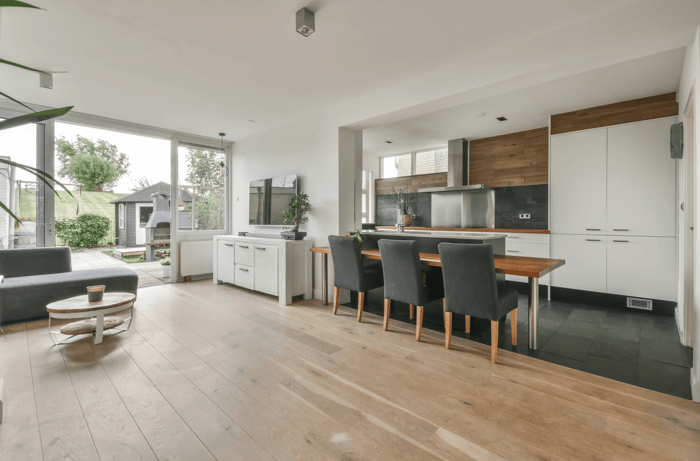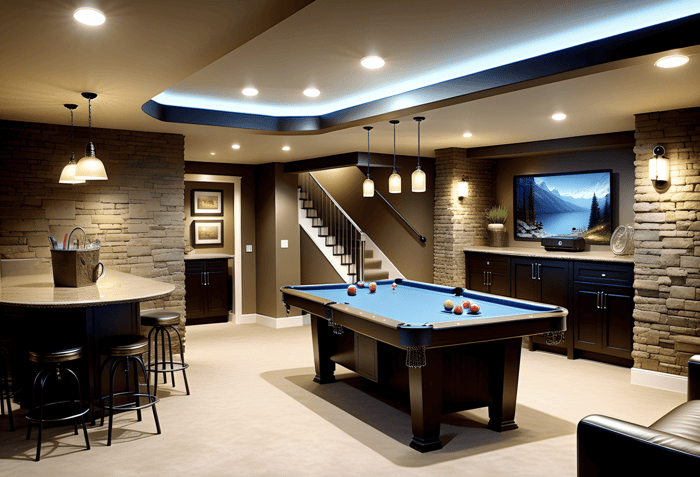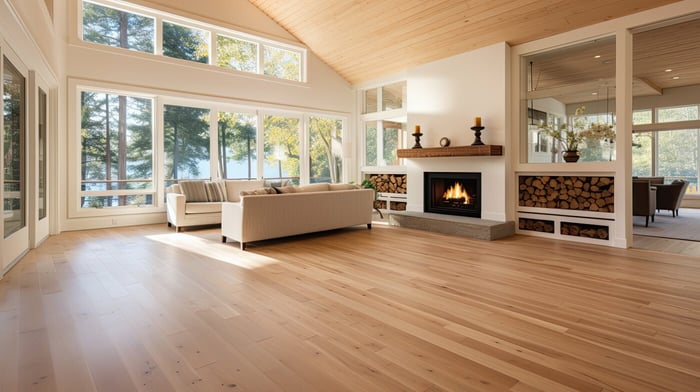Hardwood is a timeless and classic flooring option that provides unparalleled longevity and a unique touch of natural materials in your home.
While it can be said that many other flooring types also come in a variety of options and materials used for their core design (think about SPC and WPC vinyl), this holds especially true for hardwood.
Each type of wood has unique natural properties that make the end product also have distinct looks and features.
Oak, hickory, maple, bamboo…? With so many different wood species to choose from, you might be wondering: “Which one should I get?”
In this article, we will analyze the pros and cons of some of the most noteworthy wood species that are often used in hardwood production and evaluate them in terms of their hardness, durability, and aesthetic appeal.
If you prefer, you can directly explore various hardwood designs here.
Durability Rating
Before we begin the evaluation, we need to clarify the criteria. Hardwood durability is measured through a test known as the Janka rating.
This rating is assigned through a standardized testing process in which a steel ball is pressed into a wood sample, and the force required to embed the ball halfway is measured in pounds-force.
The results measured in this process are translated into what we now know as the Janka rating.
To give you a general idea of the results, softwoods hover around a 600 Janka rating (pine), moderate hardwoods range between 1000 and 2000 (oak is around 1300), and the hardest woods can go over 3500.
Broadly speaking, anything over a 1000 Janka rating is considered adequate wood for flooring products, and anything over 1500 is noteworthy for its high durability and resistance to wear and tear.
Bamboo Flooring
Although bamboo plants are technically considered grass, they still look and feel like hardwood, so we’ve included them on our list. Bamboo is known for its strength, durability, and eco-friendliness.
Pictured above: bamboo flooring designs
This flooring type typically comes in three different varieties: horizontal, vertical, and strand-woven, each with its own look and hardness.
When it comes to the hardness rating, natural bamboo’s Janka rating ranges between 1200-1400, but there is also strand-woven bamboo, which is a highly compressed form of bamboo.
The strand-woven bamboo’s Janka rating far surpasses that of any hardwood flooring, with a Janka rating in the range of 3500-5000.
The material is also known for its unique, knotty appearance. It offers a distinct style that differs from typical wood patterns, which could suit homeowners who are looking to spice up their living space.
The price of bamboo depends on the variety and design, but it generally ranges between $2 and $12.
French Oak Flooring
French Oak’s beautiful natural patterns and rich color variations make it an evergreen premium hardwood choice.
These trees grow slowly, and the space between the growth rings is compact, giving it a tight, smooth grain, and therefore a highly unique appearance.
Durability-wise, this wood species is not as resilient as some other options on this list. However, it’s still considered strong enough not to be affected by daily household activities, with its Janka rating falling around 1360.
Pictured above: french oak flooring designs
French oak is on the higher end of the price spectrum due to it being an imported hardwood, with prices typically ranging from $6 to $15, depending on the grade, finish and brand.
Hickory Flooring
Hickory is one of the most rigid and durable American hardwoods on the market.
With a rather high Janka rating of 1820, this wood species can surely take the challenge of high-traffic areas and heavy objects. This makes it a great option for households with children and pets running around.
Its hardness also makes it a low-maintenance flooring option. Regular sweeping and occasional mopping will do the job just fine.
Visually, hickory has an easily recognizable look. It comes in highly unique grain patterns and color variations, ranging from creamy whites to medium and dark browns.
This gives it a distinct and striking look, which may be a downside for people who like a more uniform wood appearance.
Pictured above: hickory flooring designs
This wood species is a mid-budget flooring option, with prices usually going between $3 to $12 per square foot.
Maple Flooring
Maple flooring is a favorite in so many households due to its exquisite durability and a light, creamy color palette. This clean, natural look makes it a perfect fit for both modern and contemporary styles of homes.
Pictured above: maple flooring design
There are some drawbacks to this hardwood species, though; Maple is more prone to react to changes in humidity and it can darken over time if frequently exposed to direct sunlight.
Its light color also makes it prone to staining. We recommend professional finishing to prevent this and to best capitalize on the natural beauty of this hardwood.
While it may be sensitive to staining and sunlight, maple hardwood options usually sit in the 1400-1500 Janka rating, which guarantees the durability and structural integrity of this flooring.
Cost-wise, maple flooring falls in the middle of the price range – typically $3 to $13 per square foot.
Red Oak Flooring
What’s not to love about red oak? It is one of the best-selling hardwood floors in the US for a reason.
Red oak usually comes in warm, reddish tones with a prominent, wavy grain pattern that adds a soft yet enchanting and cozy feel to rooms.
Pictured above: red oak flooring designs
With a Janka rating of 1290, it’s also sufficiently durable for daily wear and tear in both residential and commercial settings.
Red oak shines when it comes to price, with it being both cheaper and easier to install than, say, hickory and maple.
Its price ranges from $2 to $10 per square foot, which is definitely on the lower end of the price scale for hardwood flooring. This makes it a superb economical choice without sacrificing aesthetics.
White Oak Flooring
White oak is slightly harder than red oak and has a more subtle grain and cooler color palette that includes light browns and grays.
It complements a wide range of interior designs, from modern to traditional, which makes it a highly versatile hardwood option.
Pictured above: white oak flooring designs
One of the unique properties of white oak flooring is that it offers a substantial level of water resistance compared to other hardwood options, which makes it suitable for kitchens.
While it may not be completely waterproof, white oak is known to be quite stain-resistant, which allows for lighter color designs and a variety of finishes.
A mid-budget option, hickory can usually be bought for around $3 to $7 per square foot.
Conclusion
To make things simple, when selecting wood flooring, you should try your best to match the wood’s style to your home’s overall look while keeping each wood’s hardness and durability in mind.
For instance, if you're looking for flooring that can withstand high-traffic areas or pets and kids running around, the resilience of strand-woven bamboo and hickory make them better choices than, say, french oak.
On the other hand, white oak's water-resistant qualities make it a good choice for areas prone to moisture and spills, such as kitchens.
Ultimately, choosing the right wood flooring is about striking a balance between room design and functionality in order to create a comfortable living space for you and your family!










